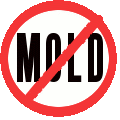What is Mold?
Molds are fungi. Molds grow throughout the natural and built environment. Tiny particles of mold are present in indoor and outdoor air. In nature, molds help break down dead materials and can be found growing on soil, foods, plant matter, and other items. Molds produce microscopic cells called "spores" which are very tiny and spread easily through the air. Live spores act like seeds, forming new mold growths (colonies) when they find the right conditions.
What does mold need to grow?
Mold only needs a few simple things to grow and multiply:
- Moisture
- Nutrients
- Suitable place to grow
Of these, controlling excess moisture is the key to preventing and stopping indoor mold growth. (ie. cracks in stucco or wood allowing mold to grow within your walls)
Are some molds more hazardous than others?
Some types of mold can produce chemical compounds (called mycotoxins) although they do not always do so. Molds that are able to produce toxins are common. In some circumstances, the toxins produced by indoor mold may cause health problems. However, all indoor mold growth is potentially harmful and should be removed promptly, no matter what types of mold is present or whether it can produce toxins.
Should I be concerned about mold in my home?
Mold should not be permitted to grow and multiply indoors or within the walls of your home. When this happens, health problems can occur and building materials, goods and furnishings may be damaged.
Can mold make me and my family sick?
Mold can affect the health of people who are exposed to it. People are mainly exposed to mold by breathing spores or other tiny fragments. People can also be exposed through skin contact with mold contaminants (for example, by touching moldy surfaces) and by swallowing it.
The type and severity of health effects that mold may produce are usually difficult to predict. The risks can vary greatly from one location to another, over time, and from person to person.
What symptoms might I see?
The most common health problems caused by indoor mold are allergy symptoms. Although other and more serious problems can occur, people exposed to mold commonly report problems such as:
- nasal and sinus congestion
- cough
- wheeze/breathing difficulties
- sore throat
- skin and eye irritation
- upper respiratory infections (including sinus)
Are the risks greater for some people?
There is wide variability in how different people are affected by indoor mold. However, the long term presence of indoor mold growth may eventually become unhealthy for anyone. The following types of people may be affected more severely and sooner than others:
- infants and children
- elderly people
- individuals with respiratory conditions or sensitivities such as allergies and asthma
- persons having weakened immune systems (for example, people with HIV infection, chemotherapy patients, organ transplant recipients)
Those with special health concerns should consult a medical professional if they feel their health is affected by indoor mold.
Mold loves paper
The spike in mold complaints invites the question: Are our homes moldier than they used to be? Some experts think the answer is "yes."
Mold outbreaks across the country have closed schools, courthouses, office buildings, apartment complexes and hotels, costing millions of dollars in repairs or losses. Public health departments have seen a surge in mold-related inquiries. Minnesota's Department of Health, for example, had fewer than 100 mold-related inquiries in 1989; it had 150 per month in 2001.
Joe Lstiburek, a Massachusetts-based building design expert, said more moisture-sensitive building materials invite mold growth. "We used to have plaster," he said. "It's drywall now. It's paper. Mold loves paper. And we're putting it on the outside now.
"We've gone from rocks and sticks to paper. Even the dumbest of the Three Little Pigs didn't build a house out of paper. While they're using building materials more susceptible to mold, many builders eliminate or don't properly install flashings and other means of preventing moisture intrusion," Lstiburek said.
The Georgia Board of Realtors in January 2002 recognized the growing problem when it added a question about mold to the long list of items sellers are asked to disclose when they put new or existing houses on the market.
Mold has crept into politics.
In 2003, 17 states introduced legislation related to mold, including bills to study health effects, license remediation firms and create new insurance regulations. Eight states enacted mold laws or resolutions.
With the 2004 state legislative season fully underway, mold still reigns as the top Indoor Air Quality issue for state legislators. More than one-half of all the proposed IAQ legislation being considered in 27 states addresses concerns about mold in indoor environments. Legislatures also are focusing on IAQ in schools and in public buildings. Here is an overview from Aerias.org, an online resource on indoor air quality.
Mold's already raised your insurance costs
In 2001, insurers paid more than $850 million against mold claims in Texas. In recent years, insured losses for mold damage have risen sharply - to $3 billion in 2002 from $700 million in 2000 for property damage alone.
Homeowners insurance rates were expected to raise 8-9% in 2004 primarily because of mold claims. In many instances after paying mold claims insurance companies have canceled policies.
Additional Resources
EPA Mold Resources
Mold Issues from Building Science Corporation
Clean up the mold around your house now! Order MonoClean


